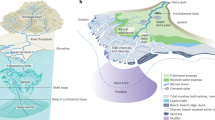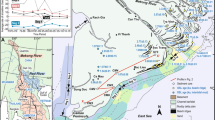Abstract
Many of the world's largest deltas are densely populated and heavily farmed. Yet many of their inhabitants are becoming increasingly vulnerable to flooding and conversions of their land to open ocean. The vulnerability is a result of sediment compaction from the removal of oil, gas and water from the delta's underlying sediments, the trapping of sediment in reservoirs upstream and floodplain engineering in combination with rising global sea level. Here we present an assessment of 33 deltas chosen to represent the world's deltas. We find that in the past decade, 85% of the deltas experienced severe flooding, resulting in the temporary submergence of 260,000 km2. We conservatively estimate that the delta surface area vulnerable to flooding could increase by 50% under the current projected values for sea-level rise in the twenty-first century. This figure could increase if the capture of sediment upstream persists and continues to prevent the growth and buffering of the deltas.
This is a preview of subscription content, access via your institution
Access options
Subscription info for Japanese customers
We have a dedicated website for our Japanese customers. Please go to natureasia.com to subscribe to this journal.
Buy this article
- Purchase on SpringerLink
- Instant access to full article PDF
Prices may be subject to local taxes which are calculated during checkout



Similar content being viewed by others
References
Syvitski, J. P. M. & Saito, Y. Morphodynamics of deltas under the influence of humans. Glob. Planet. Change 57, 261–282 (2007).
Woodroffe, C. D., Nicholls, R. J., Saito, Y., Chen, Z. & Goodbred, S. L. in Global Change and Integrated Coastal Management: The Asia–Pacific Region, Coastal Systems and Continental Margins Vol. 10 (ed. Harvey, N.) 277–314 (Springer, 2006).
Vörösmarty, C., Syvitski, J. P. M., Day, J., Paola, C. & Serebin, A. Battling to save the world's river deltas. Bull. Atom. Sci. 65, 31–43 (2009).
Nicholls, R. J. et al. in IPCC Climate Change 2007: Impacts, Adaptation and Vulnerability (eds Parry, M. L., Canziani, O. F., Palutikof, J. P., van der Linden, P. & Hanson, C. E.) 315–357 (Cambridge Univ. Press, 2007).
Syvitski, J. P. M. Deltas at risk. Sustain. Sci. 3, 23–32 (2008).
Nicholls, R. J. Coastal flooding and wetland loss in the 21st century: Changes under the SRES climate and socio-economic scenarios. Glob. Environ. Change 14, 69–86 (2004).
Day, J. W. Jr et al. Restoration of the Mississippi Delta: Lessons from hurricanes Katrina and Rita. Science 315, 1679–1684 (2007).
Turner, R. E., Swenson, E. M., Milan, C. S. & Lee, J. M. Hurricane signals in salt marsh sediments: Inorganic sources and soil volume. Limnol. Oceanogr. 52, 1231–1238 (2007).
Turner, R. E., Baustian, J. J., Swenson, E. M. & Spicer, J. S. Wetland sedimentation from hurricanes Katrina and Rita. Science 314, 449–452 (2006).
Bindoff, N. L. et al. in IPCC Climate Change 2007: The Physical Science Basis. (eds Solomon, S. et al.) 385–433 (Cambridge Univ. Press, 2007).
Church, J. A. & White, N. J. A 20th century acceleration in global sea-level rise. Geophys. Res. Lett. 33, L01602 (2006).
Milne, G. A., Gehrels, W. R., Hughes, C. W. & Tamisiea, M. E. Identifying the causes of sea-level change. Nature Geosci. 2, 471–478 (2009).
Meckel, T. A., Ten Brink, U. S. & Williams, S. J. Sediment compaction rates and subsidence in deltaic plains: Numerical constraints and stratigraphic influences. Basin Res. 19, 19–31 (2007).
Törnqvist, T. E. et al. Mississippi Delta subsidence primarily caused by compaction of Holocene strata. Nature Geosci. 1, 173–176 (2008).
Saito, Y., Chaimanee, N., Jarupongsakul, T. & Syvitski, J. P. M. Shrinking megadeltas in Asia: Sea-level rise and sediment reduction impacts from case study of the Chao Phraya Delta. Inprint Newsletter of the IGBP/IHDP Land Ocean Interaction in the Coastal Zone 2007/2, 3–9 (2007).
Caputo, M., Pieri, L. & Unghendoli, M. Geometric investigation of the subsidence in the Po Delta. Boll. Geofis. Teor. Appl. 14, 187–207 (1970).
Jouet, G., Hutton, E. W. H., Syvitski, J. P. M., Rabineau, M. & Berné, S. Modeling the isostatic effects of sealevel fluctuations on the Gulf of Lions. Comput. Geosci. 34, 1338–1357 (2008).
Ivins, E. R., Dokka, R. K. & Blom, R. G. Post-glacial sediment load and subsidence, in coastal Louisiana. Geophys. Res. Lett. 34, L16303 (2007).
Milne, G. A. & Mitrovica, J. X. Searching for eustasy in deglacial sea-level histories. Quat. Sci. Rev. 27, 2292–2302 (2008).
Dokka, R. K., Sella, G. F. & Dixon, D. H. Tectonic control of subsidence and southward displacement of southeast Louisiana with respect to stable North America. Geophys. Res. Lett. 33, L23308 (2006).
Blum, M. D., Tomkin, J. H., Purcell, A. & Lancaster, R. R. Ups and downs of the Mississippi Delta. Geology 36, 675–678 (2008).
Hutton, E. W. H. & Syvitski, J. P. M. SedFlux2.0: New advances in the seafloor evolution and stratigraphic modular modeling system. Comput. Geosci. 34, 1319–1337 (2008).
Dixon, T. H. Earth scientists and public policy: Have we failed New Orleans? Eos 89, 96 (2008).
Syvitski, J. P. M., Kettner, A. J., Correggiari, A. & Nelson, B. W. Distributary channels and their impact on sediment dispersal. Mar. Geol. 222–223, 75–94 (2005).
Milliman, J. D. & Syvitski, J. P. M. Geomorphic/tectonic control of sediment discharge to the ocean: The importance of small mountainous rivers. J. Geol. 100, 525–544 (1992).
Syvitski, J. P. M. & Milliman, J. D. Geology, geography and humans battle for dominance over the delivery of sediment to the coastal ocean. Geology 115, 1–19 (2007).
Roldolfo, K. S. & Siringan, F. P. Global sea-level rise is recognised, but flooding from anthropogenic land subsidence is ignored around northern Manila Bay, Philippines. Disasters 30, 118–139 (2006).
Holmes, D. A. The recent history of the Indus. Geog. J. 134, 367–382 (1968).
Giosan, L. et al. Recent morphodynamics of the Indus delta shore and shelf. Cont. Shelf Res. 26, 1668–1684 (2006).
Han, M., Hou, J. & Wu, L. Potential impacts of sea level rise on China's coastal environment and cities: A national assessment. J. Coastal Res. 14, 79–90 (1995).
Stanley, J. D. & Warne, A. G. Nile Delta in its destructive phase. J. Coastal Res. 14, 794–825 (1998).
Schumann, G. et al. Comparison of remotely sensed water stages from LiDAR, topographic contours and SRTM. ISPRS J. Photogram. Remote Sensing 63, 283–296 (2008).
Giosan, L. et al. Young Danube delta documents stable Black Sea level since the middle Holocene: Morphodynamic, paleogeographic, and archaeological implications. Geology 34, 757–760 (2006).
Giosan, L., Bokuniewicz, H. J., Panin, N. & Postolache, I. Longshore sediment transport pattern along the Romanian Danube delta coast. J. Coastal Res. 15, 859–871 (1999).
Goldenberg, S. B. et al. The recent increase in Atlantic hurricane activity: causes and implications. Science 293, 474–479 (2001).
Holland, G. & Webster, P. Heightened tropical cyclone activity in the North Atlantic: Natural variability or climate trend? Phil. Trans. R. Soc. A 365, 2695–2716 (2007).
Lambert, F. H., Stine, A. R., Krakauer, N. Y. & Chiang, J. C. H. How much will precipitation increase with global warming? Eos 89, 193–194 (2008).
Overeem, I. & Syvitski, J. P. M. Dynamics and Vulnerability of Delta Systems. LOICZ Reports & Studies No. 35. (GKSS Research Center, 2009).
Acknowledgements
We thank the following organizations for research funding: National Science Foundation (Cooperative Agreement 0621695), NASA (NNXOTAF2SG/P207124; NNXOTAF28G/P207124) and the Office of Naval Research (N00014-04-1-0235). Many scientists have contributed to this effort, including C. Paola (NCED), S. Peckham (CSDMS), W.-S. Kim (Univ. Illinois), J. Storms (Delft Univ. Technology) and I. Kelman (CICER).
Author information
Authors and Affiliations
Corresponding author
Supplementary information
Supplementary Information
Supplementary Information (PDF 2907 kb)
Rights and permissions
About this article
Cite this article
Syvitski, J., Kettner, A., Overeem, I. et al. Sinking deltas due to human activities. Nature Geosci 2, 681–686 (2009). https://doi.org/10.1038/ngeo629
Published:
Issue Date:
DOI: https://doi.org/10.1038/ngeo629
This article is cited by
-
Quantifying the consequences of unsustainable sand mining and cascade dams on aspects in a tropical river basin
Scientific Reports (2024)
-
Shallow-subsidence vulnerability in the city of New Orleans, southern USA
Hydrogeology Journal (2024)
-
Vernetztes Denken und Handeln für Renaturierungsmaßnahmen an Flüssen und Auen
Wasser und Abfall (2024)
-
Study on influencing factors and mechanism of land subsidence in delta resource exploitation area of Shengli oilfield
Environmental Earth Sciences (2024)
-
Adapting to sea level rise: participatory, solution-oriented policy tools in vulnerable Mediterranean areas
Environment Systems and Decisions (2024)



